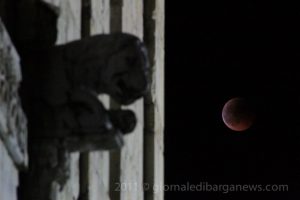 A couple of years ago there were just four of us standing up at the Duomo to watch a lunar eclipse and a pretty dismal affair it was too. In December of last year what should have been a rare event not seen in 372 years was after a long wait, unfortunately totally obscured by the clouds and went unseen (article here). Tonight, maybe because of repeated news articles on the TV there were instead many people impatiently waiting up outside the Duomo waiting for the moon to arrive and this time it was worth waiting for.
A couple of years ago there were just four of us standing up at the Duomo to watch a lunar eclipse and a pretty dismal affair it was too. In December of last year what should have been a rare event not seen in 372 years was after a long wait, unfortunately totally obscured by the clouds and went unseen (article here). Tonight, maybe because of repeated news articles on the TV there were instead many people impatiently waiting up outside the Duomo waiting for the moon to arrive and this time it was worth waiting for.
Children playing, dogs fighting, cats walking though the crowd completely unconcerned and unbothered by all the fuss but in the end after a long wait the moon did put on a spectacular show hovering just above the horizon and turning a pretty sinister blood red.
A total lunar eclipse happens when the moon, Earth and sun line up, and our home planet casts a vast shadow that engulfs the moon. When the moon moves into the darkest part of the Earth’s shadow, the umbra, it will turn a slate grey or brick red colour. The moon changes colour because blue light – and other short wavelengths – scatter more in the Earth’s atmosphere, with more red light getting through.
no images were found
Ieri sera tutti col naso all’insù per l’eclissi di luna. Per molti di noi i nostri paesi si sono trasformati in un teatro all’aperto dove abbiamo potuto assistere al fenomeno perfettamente visibile, grazie anche al cielo quasi sgombro da nubi.
Uno spettacolo naturale di ben cento minuti che ha avuto il suo picco massimo dopo le 22. In Italia la Luna è entrata nel cono d’ombra intorno alle 20.22 e ha raggiunto il suo massimo alle 22.12, per terminare a partire dalle 23.03.
Il fenomeno si verifica quando Sole Luna e Terra sono perfettamente allineati, la terra proietta nello spazio la sua ombra e la Luna vi entra un po’ alla volta, il colore rossastro è dovuto all’atmosfera del nostro pianeta che diffonde nello spazio i raggi del Sole, la luna pertanto si trova immersa nella luce soffusa e rossastra.
Un evento quanto mai unico che peraltro in un cielo quasi senza nubi ha attirato molta gente che non ha resistito di riprendere l’eclissi con macchine fotografiche e videocamere.
L’ultima eclisse totale di Luna osservabile dall’Italia si è verificata il 21 febbraio del 2008; la prossima eclissi simile si verificherà a settembre 2015 perché quella del prossimo 10 dicembre si potrà vedere solo in Australia. In realtà la prossima eclisse lunare centrale come questa, in cui la Luna viene coperta ancora di più rispetto al solito, si verificherà il 27 luglio del 2018.